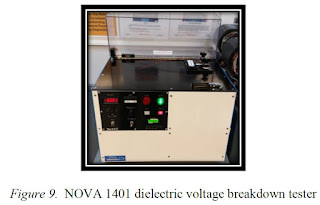quinta-feira, 3 de novembro de 2016
BREAKDOWN VOLTAGE PERFORMANCES OF ALUMINUM AND COPPER CONDUCTOR WIRE UNDER COMPRESSION STRESSES -Richard Donald Suchanek - Western Kentucky University Master of Science
BREAKDOWN VOLTAGE PERFORMANCES OF ALUMINUM AND COPPER CONDUCTOR WIRE UNDER COMPRESSION STRESSES
A Thesis Presented to The Faculty of the Department of Architectural and Manufacturing Sciences Western Kentucky University Bowling Green, Kentucky
In Partial Fulfillment Of the Requirements for the Degree Master of Science By Rich Suchanek
May 2016
ABSTRACT
In the global, competitive market of energy transformation, increased operational expenses and depletion of raw materials have resulted in companies pursuing alternate materials to reduce consumer costs. In electrical applications, energy is transformed using materials with high electrical conductive properties. The conductive material used to transmit a signal is called conductor wire and is comprised of any material that has the ability to move charged particles from one point to another without propagation or delay. The conductor wire in many applications is encapsulated in epoxy resin called enamel. The enamel is the insulation system that provides necessary dielectric clearances to prevent voltage leakage. The most common form of energy transformation is the electric motor. Both copper and aluminum conductor wire are commonly used in electric motors, but copper is preferred due to thermal and electrical properties. However, there is a significant economic incentive to convert to aluminum conductor wire. Limited white papers are available comparing the performances of the two materials; the research is limited to physical and electrical performances of the raw material and does not take into considering the insulation. The conductor wire, which includes the insulation, is susceptible to damage during the manufacturing process and is an inherent risk if not fully understood. During the blocking process, the conductor wire is pushed and compressed into lamination slots. This process changes the conductor wire outer diameter to accommodate void spaces within the lamination slots. The percentage of slot vii area occupied by the conductor wire is known as slot fill. The higher the slot fill, the more wire occupying the available space. The higher the slot fill, the more force required to fill the slots. High slot fill motor designs provide a performance advantage with little associated cost. The more wire pressed into the slot, the higher the potential efficiency gains. However, high slot fill motors are more susceptible to damage. The study is designed to evaluate and measure the durability of aluminum and copper conductor wire under simulated compression stresses. Utilizing this information, electric motor manufacturers can push current design limits without affecting conductor wire quality and reliability.
FULL THESIS LINK ORIGINAL:
http://digitalcommons.wku.edu/cgi/viewcontent.cgi?article=2611&context=theses
Assinar:
Postar comentários (Atom)





































 JOSIL ARTISTA PLASTICO FORTALEZA CEARA BRASIL AV.HERACLITO GRAÇA 41 TEL(85)32542378
JOSIL ARTISTA PLASTICO FORTALEZA CEARA BRASIL AV.HERACLITO GRAÇA 41 TEL(85)32542378
















Nenhum comentário:
Postar um comentário